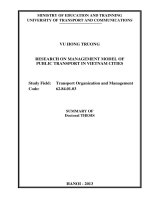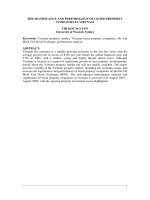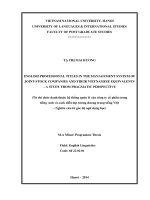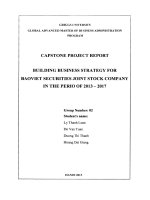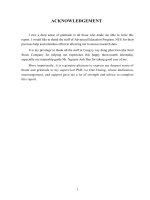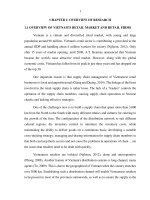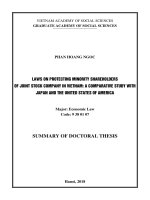Summary of Doctoral thesis: Research on the comppensation policy for managers of joint stock companies in Vietnam
Bạn đang xem bản rút gọn của tài liệu. Xem và tải ngay bản đầy đủ của tài liệu tại đây (489.5 KB, 26 trang )
1
INTRODUCTION
1. Rationable
At present, Agency cost has become a common issue and a great
challenge in financial management activities with jointstock companies around
the world. Apart from finding out effective compensation policy, avoiding the
disagreement about benefits between managers and shareholders is also a
remarkable concern of companies due to its complexity. A poor compensation
plan would encourage the maximization of current income without paying
attention to future income. More seriously, value for future shareholders would
be chosen to sacrifice for the generation of high results in short term.
Under another point of view, conflicts between stakeholders are
manifested through contradiction. Income of manager entirely depends on
business results; therefore, executives tend to limit their risk by rejecting high
profit but highrisk projects and focusing on moderately profitable but less risky
ones. On the other hand, investors tend to accept higher risks with the desire of
earning remarkable returns. As soon as this conflict is solved, company could
create more values.
Current situation in Vietnam also shows that the more competitive and
professionally oriented the market economy is, the more important this problem
could become. A large number of jointstock companies are confused in
determining the income distribution (salaries, bonuses) to the managers. This
issue results in negative impacts on compensation policy. In particular, in the
past time, there was a large number of jointstock companies in Vietnam paid
“skyhigh” incomes to managers that neither reflected the values they brought
back to enterprises nor based on any scientific foundation. In Vietnam's context,
due to some limitations in accessing to reliable sources of data, there are not
many researches about this subject, especially empirical studies.
Therefore, the topic "Research on the comppensation policy for
managers of joint stock companies in Vietnam" was selected ro research.
2. Research objectives
This thesis aims to provide scientific and experimental evidence of the
factors affecting the compensation of manager and the current situation of the
payment policy for manager among listed companies in Vietnam during the
2
period from 2010 to 2017. Based on the research results of the model combined
with compensation policy’s situation, the author gives some solutions to
improve management compensation policies in Viet Nam joint stock
companies.
3. Scope and subject of research
Research object: The compensation policy for manager (Board of
Excutive) of jointstock company listed on Viet Nam’s Stock Market
Research scope:
Times: The period from 2010 to 2017
Places: Research sample is 269 jointstock company listed on Viet Nam’s
Stock Market. The case study of compensation policy is FPT Company.
4. New contributions of the thesis:
New contribution to the literature: The thesis has codified and
formulated a theoretical framework for compensation policies for managers of
joint stock companies, such as: (i) the role and nature of the compensation
policy; (ii) The components of the compensation policy for the manager; (iii)
models of compensation for the manager; (iv) Key factors effect the
compensation for managers of JSC.
New contribution to the emprical: The thesis has analyzed the current
situation of compensation policy for managers of listed companies in the
Vietnam stock market in the period 2010 2017. The thesis provided emprical
for key factors effecting on the compensation policy for managers of listed
companies on the Vietnam stock market. In combination with the case study of
compensation for the key manager of FPT Corporation and conducted indepth
interviews with expert. From there, the conclusions were made: (i) The impact
of input factors on the management compensation policy of listed companies on
the Vietnam stock market from 2010 2017; (ii) An assessment of the
successes, limitations and reasons to make an important practical basis for
proposing solutions to improve the compensation policy in VietNam listed
companies.
New recommendation from our findings: Based on an empirical study
on the compensation for manager in Vietmam joint stock companies, my thesis
has suggested the following recommendations:: (i) The thesis proposes the
application of advanced compensation models in the world to joint stock
3
companies in Vietnam in setting up the payment policy system for managers
such as payasyougo models based on increased economic value EVA and
the ESOP payment model based on corporate valueadded; (ii) Flexibly use
shortterm and longterm criteria to measure the performance of managers as a
basis for policy development; (iii) enhancing the independence of the BOD
members in controlling the payment to the executives; and (iv) enhance the role
of the Board of Supervisors and Internal Auditors.
5. Structure
The structure of thesis consists of four following chapters:
Chương 1: Overview of literature and research methodology
Chương 2: Theory and practice of the compensation policy for manager of
joint stock company
Chương 3: Current situation of compensation policy for managers of Viet
Nam joint stock companies.
Chương 4: Recommendations to improve the compensation policy for
managers of Viet Nam joint stock companies.
CHƯƠNG 1: OVERVIEW OF LITERATURE AND RESEARCH
METHODOLOGY
1.1. Overview of literature
1.1.1. Studies on the relationship between the agency cost and the payment
policy for managers of joint stock companies
The agency cost has been mentioned quite early in various studies, but
this is a big challenge for corporate governance. This is the cost that arises
when there is a separation of ownership and management (Jensen and
Meckling, 1976). According to the agency theory given by Jensen and
Meckling (1976) the principal (who provides finance) and the agent (who
manages the firm) both want to maximize their utility1 and in doing so they will
not act in the best interest for each other. They further suggest that the
shareholders (principal) can control the actions of the agent by methods like
auditing, formal control systems, budget restrictions and the establishment of
4
incentive compensation system. An implication of this theory can be that it is
always complicated to evaluate the actions of the agent i.e. whether their
actions have a positive or negative effect on the firm value. That is why it
would be in the interest of the shareholders to align the pay of the agent with
the performance of the firm.
In a number of studies on the agency cost, studies dealt with the
relationship between agency costs and executive compensation for jointstock
companies, including: Jensen and Meckling (1976); Lucian Arye Bebchuk &
Jesse M. Fried (2003); Hongxia Li and Liming Cui (2003) or incountry studies
such as Ha Thi Thu Hang (2007); Nguyen Ngoc Thanh (2010); Than Thi Thu
Thuy et al. (2014).
1.1.2. Studies on executive compensation models
Tại Việt Nam, các nghiên cứu độc lập về chính sách chi trả cho nhà
quản lý trong các doanh nghiệp nói chung và các CTCP niêm yết nói riêng còn
khá mới mẻ, có ít nghiên cứu xem xét vấn đề này. Các nghiên cứu chủ yếu
tập trung vào nghiên cứu từng mảng vấn đề riêng rẽ như: vấn đề tiền lương,
tiền thưởng của người lao động nói chung trong các doanh nghiệp. Trong các
nghiên cứu liên quan trực tiếp đến vấn đề này, có thể kể đến một số các
công trình nghiên cứu chủ yếu sau đây: Bùi Xuân Chung (2009); Nguyễn Văn
Thanh (2005); Alex Edmans, Xavier Gabaix, Tomasz Sadzik, Yuliy Sannikov
(2012); Hoàng Văn Hải, Nguyễn Anh Tuấn và Nguyễn Phương Mai (2011);
Trần Kim Dung (2014).
1.1.3. Studies on the Factors affecting Executive compensation.
* Effect of firm performance on executive compensation
Most studies on the relationship between firm performance and executive
compensation show that there is a positive relationship between firm
performance and executive pay. Both Usman Tariq (2010), Ntim et al (2015)
and Johnson (1982) find a positive relationship between accountingbased firm
performance and executive compensation. Similarly, Belliveau et al. (1996),
Finkelstein and Boyd (1998) , Core et al. (1999), Cyert et al. (2002), Kato and
Long (2006), Ozkan (2011), Farmer et al. (2013), Schultz et al. (2013) and
Swatdikun (2013a) show that marketbasedperformance has a positive
relationship to executive remuneration.
In contrast, Brick et al. (2005), Zhou (2000) shown that as a negative
5
relationship between firm performance and executive compensation.
* Effect of corporate governance on executive compensation
nAumber of studies show that executive remuneration is not only
influenced by firm performance, but also by corporate governance. For
example, Cyert et al. (2002) suggest that executive cash compensation is higher
when the board of directors is represented by greater outside directors. Shah et
al. (2009 found that CEO pay were a function of firm performance and
corporate governance such as: CEOs' talents, board independence, board size,
Equity and independence of the audit committee. Berkema and Mejia (1998)
identified important factors affecting the level of pay for CEOs; These include:
(i) Market forces, (ii) Ownership structure, and Large shareholders
(blockholders). And in particular, the appearance of a remuneration committees.
* Effect of corporate ownership on executive compensation
Shleifer và Vishny (1986) shown that concentrated ownership has been
one of the control mechanisms of managers. It follows that based on these
arguments, ownership concentration negatively affects total executive
compensation. The results of empirical studies on the concentration of
ownership revealed, overall, a negative influence of the presence of controlling
shareholders on executive compensation (Haid and Yurtoglu (2006) on the
German market and Mehran (1995) on the U.S. market)
In the AngloSaxon context, Lambert et al. (1993) and Core et al. (1999)
verify that the level of executive compensation is lower when the executives’
participation in capital holding is larger. Zhaoyang Gu, Kun Wang and Xing
Xiao (2010) verify that there is the relationship between Government control
and executive Compensation.
1.1.4. Research gaps
Testing the factor affecting to executive compensation in Viet Nam listed
companies is an essential requirement.
Studies on the compensation policy for managers in Vietnam has been
limited to qualitative analysis methods and descriptions of basic theoretical
frameworks, thus providing emprirical evidence is needed.
My thesis targets to answer the following research questions:
Question 1. What is the current situation of the compensation policy for
managers and the application of compensation models in Viet Nam listed
6
companies?
Question 2. What factors impacts to the management compensation of
joint stock companies are?
Question 3. What are the achievements and limitations on the
compensation policy for managers in Vietnam?
Question 4. What recommendations and solutions should be implemented
in Vietnam listed companies?
7
1.2. Research model of the thesis
Research on the comppensation policy for managers of joint stock companies in Vietnam
Theoretical Framework and Practice of
comppensation policy
Theory of
manageme
nt and
manager of
joint stock
companies
Theory of
agency cost
and The
compensatio
n policy for
manager
Experiences
in building
compensatio
n policy for
managers of
joint stock
companies
in the world
The current situation of compensation
for managers in VietNam
Overview of
The current
situation of
executive
compensation
policy in
VietNam
listed
company
Testing the
impact of
factors on
the
compensatio
n policy for
managers of
listed
companies in
Viet Nam
Case study
of
compensati
on policy
for
managers of
FPT
Corporation
RECOMMENDATIONS TO COMPLETE THE COMPENSATION POLICY FOR MANAGERS OF
JOINTSTOCK COMPANIES IN VIETNAM
1.3. Methods of data collecting and data processing
Methods of data collecting: Primary data were collected through expert
interviews. Secondary data were collected from the financial statements and the
annual report audited.
Methods of data processing: The collected data will be imported and the
storage inti data files and processed with Eview software and Exel…
8
CHƯƠNG 2: THEORY AND PRACTIVE OF THE COMPENSATION
POLICY FOR MANAGER OF JOINT STOCK COMPANY
2.1. Theory of management and manager of joint stock companies
2.1.1. Overview of joint stock company
A joint stock company (JSC) is a business entity in which shares of the
company's stock can be bought and sold by shareholders. Each shareholder
owns company stock in proportion, evidenced by their shares (certificates of
ownership).
Joint Stock Company is divided into 3 types: Private Stock Company;
Public Stock Company; Listed Company.
* The internal structure system of joint stock company
The General Meeting of Shareholders (AGM) is composed of all
shareholders with voting rights, which is the highest decisionmaking body of
the company.
The Board of Directors (or Board of Directors Board of Directors) is
elected by the owners to manage and run the company on their behalf.
The Executive Board is a collection of individuals who hold the highest
executive positions in a joint venture, headed by an executive director (director
or general director) assigned by the Board of Directors to manage and run the
business. The Executive Board is entrusted with the daytoday management of
the business, implementing the directions, resolutions and conclusions of the
Board of Directors and the General Meeting of Shareholders.
2.1.2. The defenition manager of joint stock company
The manager of a jointstock company is the person who holds the key
managerial positions capable of directing the direct management of the
activities of the various sections of the company following a common strategy
to achieve the objectives of firm, including the members of the executive board.
2.2. The compensation policy for manager
2.2.1. Theory agency cost and the role of Executive compensation in
resolving conflicts of agency problem in Joint Stock Companies
According to Jensen and Meckling (1976), Fama and Jensen (1983), the
agency problem may exist between the owner (shareholders) and the agencies
(BoD and BoE) or even among BoD and BoE. This problem is clearly revealed
9
when the independence and supervisory functions of the BoD turns out to be
ineffective. The solution to limit the issue between shareholders and BoD is to
increase the supervisory function of the BoD on the one hand and to complete
the structure of income package for the BoE on the other hand so that the
benefits of both parties could be harmonized.
According to researches about agency costs, the basic principles that
companies need to master when developing a reasonable income policy for
executives include:
(i) The income payment policy should have the effect of encouraging
BoE to work with the utmost effort. In order to do so, the level of income must
be proportional to the level of effort of the board;
(ii) The income payment policy should encourage BoE to get balance
between the shortterm and longterm interests of the business the benefits of
shareholders.
(iii) Ensure risk management at all levels for enterprises.
2.2.2. The concept and nature of the compensation policy for manager
Executive compensation or executive pay policy of the joint stock
company is the whole system of regulations on criteria for determining the total
pay and method of payment to managers for the purpose of treating them.
In other words, the compensation policy for manager is the policy that the
BOD provide financial and nonfinancial compensation for managers of the
company, which describes in detail the structure of the payment components
and conditions apply specifically for managers.
Generally, It is typically a mixture of salary, bonuses, shares of or call
options on the company stock, benefits, and perquisites, ideally configured to
take into account government regulations, tax law, the desires of the
organization and the executive, and rewards for performance.
2.2.3. The basic tools of compensation or remuneration
Salary
Shortterm incentives (STIs), sometimes known as bonuses
Longterm incentive plans (LTIPs)
Employee benefits
Paid expenses (perquisites)
Insurance
10
2.2.4. The forms of compensation policy for manager
Cash compensation is a form of payment made to managers dealing with
or responsible for cash flow in paydeskk.
Equity compensation is a form of payment an organization can offer
managers to partake in ownership of the firm. It is noncash pay that is offered
to managers, including options, restricted stock and performance shares.
Benefits: The company can pay for the managers with the products and
services or programs company uses to supplement managers’ compensation,
such as paid time off, medical insurance, company car, and more…
2.3. The compensation models for manager of the jont stock company
2.3.1. Salary payment models
The payroll model is based on the traditional salary scale: it is a state
payroll system, or is designed according to the same principle with some basic
characteristics such as attachment to seniority, degree ... instead of actual
capacity and results.
An additional pay scale beyond managerial leverage is a model for
calculating salaries based on criteria other than the traditional salary system.
This system strives to create a reasonable income gap between managerial titles
and ordinary workers.
3P compensation Model: 3P compensation is a combination of pay for
position, Person and Performance.
2.3.2. Incentive compensation models
Incentive compensation model based on profit: One of the criteria for
determining the level of pay for managers is profit (profit exceeds the annual
plan of the business).
Incentive compensation model based on the results of the increase in the
value of the enterprise or stock price: The objective of the investor is to
maximize the value of the firm, thus linking the manager's income with Stock
price will help unify the goals of managers and investors, thus limiting
repatriation costs, including:
ESOP Employee Stock Ownership Plan.
SO Stock Option
MBO – Management Buy Out)
EVA – Economic Value Added
11
2.4. The factors affecting to compensation policy
2.4.1. The internal factors
Firm Performance
Firm Size
Board of Director Size
Company Ownership
2.4.2. The managerial factors
Maintain managerial positions and experience of the manager
The potential of the manager
Viewpoint and vision of the manager
Performance of manager
2.4.3. The other factors
Scarcity of labor force management in the labor market
The nature of the work of the manager
The development cycle of the economy
Industry
2.5. Experiences in building compensation policy for managers of joint
stock companies in the world
2.5.1. In Australia
Australian listed companies are also paying close attention to the
executive pay policy. Remuneration for managers is increasing over time. The
structure of longterm bonus, bonus and stockbased incentives encourages
managers to engage and engage in longerterm engagements with the company.
A number of studies have shown that increasing the compensation rates of
Australia's 200 largest listed companies over the past 20 years has a linear
relationship with the company's performance (2009).
2.5.2. In USA
According to a study by the US Groom Law Firm in 2011 on the
guidelines for payment regulations for managers of listed companies by the US
Securities and Exchange Commission, the SEC asked The public disclosure of
all information to clarify the policy of the companies to pay for the manager.
Some of the divisions included in the payroll policy for managers of a listed
company in the United States include: Basic salary; Reward incentives with
12
shortterm focus; Longterm incentive payments; Enhanced welfare policy
packages; Other benefits and conditions, such as car and club membership. In
addition, USbased companies also use a "hell of a hell" bonus policy for
executives from rival companies to compensate for their money. Valuable from
the stock options of the old company.
2.5.3. In China
Payment policy for executives in China is different from payment policy
in Australia and USA but the trend is changing rapidly in recent times. Based
on a study by Conyon (2017), executive pay policy in China now largely
consists of only two salaries and bonuses, for stock options and incentives.
Shares are relatively rare elements in China's senior management pay package.
2.5.4. Lessons for joint stock companies in Vietnam:
Firstly, to determine the structure of components in the compensation
system to ensure reasonable incentives, gradually reduce the proportion of fixed
wages, increase the proportion of bonuses, longterm incentives.
Secondly, limit the total annual cash compensation for managers.
Thirdly, use a comprehensive assessment system with a combination of
different indicators as the basis for determining the level of pay for managers,
including traditional criteria such as profitability, turnover, price ... and modern
norms such as EVA, MVA ...
The Fourth, establish and improve Remuneration Board.
CHAPTER 3: THE CURRENT SITUATION OF COMPENSATION
POLICY FOR MANAGERS IN VIET NAM JOINTSTOCK
COMPANIES
3.1. Overview of joint stock companies listed on Vietnam's stock market
The number of listed companies is increasing, which is one of the signs
that the growth of the stock market in Vietnam. From the perspective of
investors, the number of listed companies increased means the increase of
goods and investment opportunities in the market. As of the beginning of 2018,
the proportion of listed companies classified by sectors on the HNX is as
follows: The number of listed companies occupying the highest proportion on
13
the HNX are companies operating in the industry. with 123 listed companies,
followed by the construction and services trade. The number of companies
listed on HNX is the lowest among companies in the agriculture, forestry and
fishery sectors with only two companies.
3.2. The current situation of executive compensation policy in VietNam
listed company
3.2.1 Overview of The current situation of executive compensation policy in
VietNam listed company
When considering the implementation of the policy of paying a manager of a
joint stock company, the factors to be considered are the total annual payment
and the structure of payments to the manager. In general, the level of payment
for managers of companies listed on the Vietnam stock market tends to increase
over the years from 2010 to 2017, especially for companies in the two financial
sectors and Agriculture and Forestry Fisheries. Compensation for managers in
the telecommunication and hospitality services sector is not very volatile as
these are basic sectors so the performance of companies is not affected much.
for the period 2010 2016. The industry that the listed companies pay the
lowest for managers is the science and technology sector and the average pay
for the management team of a company. over $ 1.2 billion per year, while the
industry's highest payouts for managers are for companies operating in the
financial and real estate industries with an average payout per company. is 4.08
billion per year (financial sector) and 3.75 billion per year (real estate). The
payoffs for managers of listed companies operating in different sectors also
differed by sector.
3.2.2. The situation of using models in the payment policy for managers of
joint stock companies listed in Vietnam
According to a survey of the statutory salary scheme of JSCs in Vietnam,
100% of JSCs now apply the basic salary model based on the salary scale based
on the basic salary and minimum salary of the region. State regulations.
However, each company, based on the characteristics and size of its business
through the Board of Directors, will set the average base salary, adjustment
factor in different salary scales.
14
The level of adjustment of the legal provisions for the policy of payment
to managers in stateowned and stateowned share capital companies in
Vietnam also varies considerably.
* The current status of applying the ESOP model in the payment policy
for managers of Vietnam JSC
In 2010, only three listed companies in the Vietnam stock market have
applied the ESOP model in implementing the payment policy for their key
managers, so far there have been about More than 30 listed companies
implement a payout policy based on ESOP. Applying this model has opened up
a new era of competition in the senior managerial labor market. These
compensation programs are extremely important because it helps to motivate
the managers in the corporation to strive hard for shareholders. It also
eliminates the status of managers in the business rather than the growth of the
company to enjoy the ESOP is focused on making money from the company.
Of course, ESOP is only the most effective when it is a longterm program and
associated with the development of the company that these managers bring. It
would be pointless if ESOP was implemented without the close cohesion of the
company's achievements with these awards.
3.2.3. Case study of compensation policy for managers of FPT Corporation
FPT Joint Stock Company is a typical listing on the Vietnam stock market
when applying various payment policy models to incentivize key managers,
including: payment policy Cash bonuses are based on the payroll scale and the
ESOP bonus policy. Payment policy for managers was promulgated by FPT
Board of Directors and applied to attract, retain and negotiate contracts for key
management personnel in the company.
Input criteria are used to develop a management pay plan for FPT,
including the following four criteria: (i) Relevance to work performance,
contribution to FPT; (2) Competition by market; (3) Encourage increased
productivity and quality of work; (4) Fairness and transparency.
The components of the compensation policy system applied exclusively
to FPT managers are classified into the following categories: Salary (monthly
salary (12 months); Monthly salary (13 months) depending on the business
situation of the corporation and rewarded on the occasion of the establishment
of FPT 13/9 and Lunar New Year), Allowance for managers (travel, mobile
15
phone, part time Bonus (Business Performance Bonus and Performance Bonus)
and Social Welfare (Social Insurance / Medical / Unemployment Insurance,
Health Check / Insurance). FPT Care, vacation mode ...).
In order to implement the salary and bonus policy for key managers at the
corporation level and member company level, FPT assigns staffs according to
each job sector and then builds a payroll system. and the bonus policy model
associated with each job segment in the salary scale;
Regarding the cash compensation policy: Based on the business results,
the annual charter will determine the percentage of profit after tax (not
exceeding 0.49%) to pay bonuses. managers. In this pay system, the manager's
cash income is divided into two categories: fixed income, earnings based on
performance (bonuses). In particular, the soft wage is expected to account for
40 to 50%.
Regarding the incentive policy by rewarding ESOP shares to the
managers of FPT: The source of the bonus sharebased policy is derived from
the aftertax profits and the equity fund issued for the purpose of official bonus
granted by FPT. put on and put into use. Determining the percentage of
deductions to be paid to personnel with outstanding annual contributions is
decided by the Board of Directors based on the business results of that year.
The right to buy shares at preferential prices is reserved for managers who have
2 years of continuous working experience. The total volume issued under this
Program is not more than 0.5% of charter capital at the time of issue and the
annual percentage rate is based on annual profit growth. Time and the list of
managers of FPT were implemented by the Board of Directors. The plan was
developed and decided based on the performance of each manager (KPIs) and
the achievement of the objectives of the plan. annual profit.
Thus, FPT also has a policy of paying special treatment to managers,
which is associated with strong incentive incentives. Current payment policy of
FPT is transparent to every staff member and is developed for all managers and
leaders of the company: 100% of staff know His annual income plan from the
beginning of the year. This is to create motivation, direct encouragement to
each individual. However, the payment policy has some disadvantages such as:
The share issue rate for ESOP program applied to managers is low and the issue
price is not attractive in the context of market. stock market is still quiet; The
16
form of cash reward is deducted from profit after tax is quite simple and also
depends much on the payroll; Reward structure, though, has increased the
proportion of bonuses but still focuses on shortterm bonuses in cash. There are
no longterm bonuses that combine the benefits of longterm management with
the company.
3.3. Testing the impact of factors on the compensation policy for managers
of joint stock companies listed in Vietnam
3.3.1. Hypothesis and research model
* Dependent variable: Total manager/executives compensation – TCOM
* Independent variable Measurement of impact factors and research
hypothesis
Firm Performanc: ROE (Return on Equity)
Hypothesis H1: ROE is positively related to the compensation of manager
Board size: Board size is measured by the number of board members in
the board.
Hypothesis H2: A large board of directors implies greater compensation
given to the Excutives.
Firm size = Ln(TotalAsset)
Hypothesis H3: Bigger companies pay manager more
Nonexecutive Directors:
Hypothesis H4: The high proportion of nonexecutive directors is
negatively related compensation of managers
Manager ownership:
Hypothesis H5: Manager ownership has a positive relationship with
compensation of managers
Chair ownership:
Hypothesis H6: Chair ownership is inversely related to the compensation
of managers
Foreign ownership:
Hypothesis H7: Foreign ownership affects the total level of pay for
managers.
Government ownership:
Hypothesis H8: Highly stateowned companies will have a positive
impact on the total level of management pay
17
Growth: measured by the difference between the market value and the
book value of the company.
Hypothesis H9: High growth companies will have a positive impact on
the total level of management pay
Industry:
Hypothesis H10: Industry affect the policy of paying to managers of JSC.
Research model:
TCOMit = α + β1ROEit + β2BSIZEit + β3FSIZEit + β4NEDSit + β5CEO_OWNit +
β6CHAIR_OWNit
+ β7FR_OWNit + β8GOV_OWNit + β9GROWTH + β10INDUST +
εit
3.3.2. The results of testing data
After studying the relevant theoretical basics, proceeding to build the
research model, then studying the implementation of necessary tests and model
regression with the appropriate method.
* Descriptive Statistics
* Dependent variable: Total manager/executives compensation – TCOM
The average value of total pay for key executives of the listed companies
on HOSE and HNX is about 2854,851 million dong and the variation between
the companies in the sample was rather large. Vinamik JSC is the highest
paying company with the total amount of over 90786 million VND in 2017
while the lowest paid company is Binh Thuan Mineral Industry JSC. VND 72
million in 2017.
However, for the TCOM variable (natural logarithm of COM) varied
from the minimum value of 18.1% to the maximum value of 25.2%, with an
average of 21.3%, the distribution of the variable This is the standard deviation
(Kurtosis equals 4.19 and skewness is 0.28) and positively influences the
research process.
* Independent variable
Return on equity (ROE): The average ROE of companies in the period
2010 to 2016 is approximately 10.9%. Ca Mau Seafood Joint Stock Company
has the lowest ROE of 367% in FY2013 due to negative profit of VND126
billion. The company with the largest ROE in 2016 is South Gas Joint Stock
Company with the ratio of 78.3%. The difference between the average and the
18
actual ROE of companies is quite large with a standard deviation of 18.9%.
This reflects the efficiency of using equity of listed companies with a large
difference, some companies operating losses, negative profit leads to negative
ROE, according to the survey results of companies in Research sample, the
proportion of companies with the highest ROE in 3 years in 2015, 2016, 2017
all accounted for 5.95%.
Firm Size (FSIZE): The results of the statistical analysis show that the
natural logarithmic value of the total assets of the JSCs in the sample is
approximately 27.12. Over the period of 6 years, from 2010 to 2016, the total
assets of listed companies on the Vietnam stock market reached the highest
level of 180,450,850 million, this is the total asset size of Vingroup Group
Corporation in 2016 The smallest asset size is 3017.8 million, this is the size of
Nam Viet Seafood Joint Stock Company. The deviation between the average
value and the total asset value of the group of companies is very high with high
standard deviations, due to differences in business lines, financial capacity.
Board Size (BSIZE) and Nonexecutive Directors (NEDs): The average
size of the board in the sample was 5.49 with a maximum of 11 persons and a
minimum of 3, which is in line with current regulations on the number of board
members. At the same time, the average number of nonexecutive directors is
59% of the board of listed companies.
Company ownership: The shareholding ratio of the shareholders is
7.97% for the CEO, 14.4% for the Chairman, 8% for the CEO. owned by
foreign investors and 25.1% owned by the state. The company with the largest
shareholding of the state is Dien Quang Lamp Joint Stock Company (87.4%) in
2014. However, the proportion of state ownership is uneven among companies
in the sample and unstable. Between the years in the study period, the volatility
was stronger than the ownership of the remaining groups represented by the
highest standard deviation (24.56%). This is followed by the ownership of the
director and the chairman of the board of directors, which attains the highest
value of 85.39% in 2013 of Rang Dong Plastic JSC when the company's CEO
also holds the chairmanship. Board of Directors. The lowest is the ownership
ratio of foreign investors with the highest foreign ownership ratio of 80% in
2015 and 2016 of Taya Vietnam Electric Wire and Cable JSC. possesses the
least fluctuation with a standard deviation of 12.4%.
19
* Correlation matrix
The results of the analysis of the correlation coefficient between the
explanatory variables show that there are no pairs of variables with rij> 0.8
correlation coefficient, while most linear relationships between the explanatory
variables are just below 0.3. Thus, it can be said that there is no strong
autocorrelation between the explanatory variables in the model, so the
probability of occurring multicollinearity is very low or not so does not affect
the accuracy. of the estimates, support for the study could use these variables to
analyze the linear regression model.
* Heteroskedasticity Test and Serial Correlation LM Test
The first step of the study was to run the Pool OLS regression model and
then perform the two defect tests of the model: the variance of the variance (by
the Heteroskedasticity Test: White) and the selfcorrelation for the Prob Index.
ChiSquare is less than 5%. This shows that the OLS regression model has the
variance of the change error and the autocorrelation of the error. Thus, the least
squaresized Pool OLS model is not suitable for explaining the regression results
due to the existence of variance phenomena of change error and selfcorrelation
of the error. number. Therefore, the study will continue to regression with the
FEM and REM models, and to select one of these models to estimate the
regression model that measures the effect of variable factors on the variables.
Dependent of companies listed on the Vietnam stock market, Hausman's thesis
(1978). The results of Hausman's (1978) test showed that ChiSq (10) =
100.232058 statistically significant at Prob level = 0.0000 <5% should refute
the hypothesis of accepting H1 hypothesis. Therefore, the REM model is
suitable for analyzing the impact of factors on the payment policy of managers
of listed companies on the Vietnam stock market. In addition, when comparing
the R2 of the FEM and REM models, the R2 of the FEM model is 0.84 which is
significantly higher than the R2 of the REM of 0.19. This further suggests that
the FEM model is capable of explaining the effect of independent variables on
the dependent variable better.
* Result of Regression model
The above results show that the FEM model is appropriate and the study
will use this model to explain the regression results. The FEM model is an
appropriate regression model for measuring and evaluating the impact of factors
20
on total managerial pay a measure of managerial compensation. Thus, the
author uses the results of the REM model to discuss the results of the study, the
hypothesis of the study, and thus provide an assessment of the different factors
affecting the homepayment policy. management of the JSC. Evaluation of the
fit of the regression model using the coefficient of determination R2 is an
important step to determine the effectiveness and statistical significance of the
model. The value of R2 will be in the range of 0 to 1, the greater the R2 the
higher the level of interpretation of the model and the more meaningful. The
results of running the regression model for R2 (for the selected FEM model)
were 0.84 which means that 84% of the variation of the TCOM dependent
variable was explained by the regression model with variables explain ROE.
FSIZE, BSIZE, NEDs, CEO_OWN, CHAIR_GOV, FR_OWN, GOV_OWN,
INDUST. The remaining 16% variation of TCOM is explained by other factors
that are not quantified and included in the model.
3.3.3. Results Discussion
Before discussing the results, the study will summarize the expectations
for the relationship between the independent variable and the dependent
variable and the results of the study after estimating the regression model of the
factors influencing the compensation
Based on the above results, after running the regression models with 9
explanatory variables and 1 control variable, the results showed that there are 6
factor variables affecting the total payment for Key executives of listed
companies on HOSE and HOSE; Of these, 5 were statistically significant (p
value <5%) including: ROE, BSIZE, Firm Size (FSIZE) The percentage of non
executive directors (NEDs) and CEO's (CEO_OWN) and one statistically
significant (with a pvalue <10%) is the share of ownership Chairman of the
Board (CHAIR_OWN). The level of explanation of the regression model of the
groups of factors affecting total managerial compensation (TCOM) is quite high
at nearly 84%. However, the impact on the total level of payments for key
managers of listed companies remains a number of other variables that the
research has not yet addressed as well as the determinants. Other things that can
not be quantified are 16%.
3.4. General assessment of the current status of compensation policies for
managers of joint stock companies listed on the Vietnam stock market.
21
3.4.1. The obtained results
First of all, when developing the compensation for managers, listed
companies on Vietnam stock market have considered some important factors
such as profit, profit growth, Return on Equity, Growth in Enterprise Asset ...
Secondly, the structure of the components of the payment policy tends to
change in a positive way, gradually reducing the proportion of fixed payments
that do not reflect the capacity and effectiveness of the public. job.
Thirdly, JSCs have used a variety of payment models to design
managerial payment policies, in which the general trend of listed companies on
the stock market in Vietnam is to approach the payment models advanced in the
world such as stock bonus, stock options, ...
Fourthly, by applying a combination of different payment policy models
in both cash and stock to managers, some of these listed companies had better
results than the applied group of incomplete.
Fifth, ESOP has become an effective tool to keep talented managers out
of competition for other companies' human resources.
3.4.2. The limitations in current compensation policy
• When setting up a payroll policy for managers, most of the listed
companies do not consider the impact of the growth factor (increasing the value
of the firm / share value).
• With the current payment policy, the structure of the "hard" component
of Vietnamese jointstock companies still accounts for about 60% of the total
package of compensation packages.
• The level of deductions for bonus and welfare fund for managers is
usually 25% of profit after tax or profit exceeding plan. With large listed
companies, aftertax profit of up to a thousand billion, the deduction of 2 to 5%
will give a very high absolute value.
• There is also the phenomenon of accounting fraud and fraud to benefit
from incentives such as cash incentives, bonus shares based on results of
accounting profit.
• For listed companies applying ESOP in the development of managerial
payment policies, there are also some negative impacts on the operation of the
company.
22
• For the group of stateowned capitals, the policy of paying for key
managers is less linked to the business results and the dependency is more
regulated by the law.
The limitation’s causes
• The quality of corporate governance of many companies in Vietnam is
low.
• Companies have not built up reasonable "pay" plans for managers based
on advanced payment models.
• Compensation management faced many constraints.
• It is not reasonable to associate the salary with the absolute profit of the
company.
• The role of the Board of Supervisors and Internal Auditors in the
payment process for managers is still limited.
CHAPTER 4: RECOMMENDATIONS TO COMPLETE THE
COMPENSATION POLICY FOR MANAGERS OF JOINTSTOCK
COMPANIES IN VIETNAM
4.1. Objectives and principles of developing compensation policies for
managers in joint stock companies in Vietnam
4.1.1. Objectives of developing compensation policies for managers
Facilitates a more comprehensive payment policy with a variety of forms
and payments to managers.
The payment policy should be linked to the performance of the manager in
the short and long term, it means connected and serve effectively for the
business strategy.
Financial discipline in developing compensation policy.
Compensation policy should combine the company's goals with the goal of
the manager
4.1.2. principles of developing compensation policies for managers
Compensation policy must be based on the principle of adequate and proper
assessment of internal and external factors.
23
Compensation policy must be based on the principle of balancing the
interests of shareholders and the interests of the manager
Consistency and compliance in the development and implementation of
Compensation policies
Compensation policy must be based on the principle of risk assessment and
internal control
4.2. Solutions to improve the Compensation policy to managers of joint
stock companies in Vietnam
4.2.1. Application of modern payment models in the development of the
payment system for managers , such as
The compensation policy is by SO / ESOP
EVAbased cash compensation policy
4.2.2. Flexible use of performance measurement criteria by managers as a
basis for policy development
First of all, JSCs need to add a strong and accurate rating system to their
value proposition, as well as the added value that managers make, such as
growth, level of stock price increase ...
Secondly, the payment policy must be closely linked with the criteria of
the company's production efficiency and success.
Thirdly, in addition to the criteria for evaluating company performance
based on subjective accounting data such as profitability, it is necessary to add
criteria for longterm objective development. Objective measures such as human
resources, value added …
4.2.3. Restructure the components of the compensationpolicy to manager
Basic salary and allowances should be a small part of the total payment.
Bonus, stock options and a limited number of bonus shares when the company's
performance exceeds its target should be dominant in the pay structure of senior
executives.
4.2.4. Enhancing the role of the Board of Supervisors and Internal Auditors
The board of directors and executives are the actual executives of the
company's daytoday business operations. Meanwhile, the Board of
Supervisors and Internal Auditors serve as the specialized body responsible for
24
monitoring and evaluating the performance of the Board of Directors and
executives for the benefit of the shareholders of the Company.
4.2.5. Enhance the independence of the BOD members in controlling pay for
executives
The best practice is based on lessons from international experience, to
ensure "independence" requires a certain percentage of board members, usually
onethird or more of the number of members. The board of directors must be
"independent", meaning that the member has the capacity to assess clearly and
objectively at all times.
4.2.6. For stateowned joint stock companies, the compensation policy for
managers should be "personalized".
4.3. Recommendation
4.3.1. For government agencies
Firstly, it is possible to consider issuing a regulation on the pay gap
between managers and the most typical employees (who may be the longest in
the company) and encourage Companies should not pass.
* Secondly, reduce the proportion of state capital in stateowned
companies with a high proportion of state capital, by facilitating divestment of
companies.
* Thirdly, the current regulations on salaries, bonuses and remuneration
for managers of JSCs with stateowned capital should be adjusted in a way that
is more appropriate to the practice of each enterprise.
* Fourthly, the salary payment mechanism must be reformed along with
the reform of the human management mechanism.
4.3.2.For the State Securities Commission
* Firstly, the requirement for more transparency about payment
information for managers.
* Secondly, strengthen the training, improve the quality of corporate
governance for managers and managers of JSC.
* Thirdly, gradually reduce and abolish the practice of an individual who
plays the role of chairman and plays the role of CEO at medium and large listed
companies on the stock market. Male. Accompanying that, is to enhance the
role of independent board members to oversee the operations of executive
managers.
25
CONCLUSIONS
Since the opening of the economy, Viet Nam JSCs have grown
vigorously in both width and depth. The number and size of joint ventures have
been increasing dramatically after nearly 30 years of opening up of the
economy. The companies in Vietnam have played an important role in the
industrialization and modernization of the economy, attracting a large number
of laborers and contributing to GDP growth. Moreover, the development of
joint stock companies in Vietnam, especially listed companies, has had a great
impact on the sustainable development of the market economy, contributing
positively to the development of the Vietnamese stock market. Male. In that
career, can not fail to mention the role of the managers of the JSC. Employee
compensation policy is an important tool in influencing performance to help
managers work for the company's growth in the short and long term.
New contribution to the literature: The thesis has codified and
formulated a theoretical framework for compensation policies for managers of
joint stock companies, such as: (i) the role and nature of the compensation
policy; (ii) The components of the compensation policy for the manager; (iii)
models of compensation for the manager; (iv) Key factors effect the
compensation for managers of JSC.
New contribution to the emprical: The thesis has analyzed the current
situation of compensation policy for managers of listed companies in the
Vietnam stock market in the period 2010 2017. The thesis provided emprical
for key factors effecting on the compensation policy for managers of listed
companies on the Vietnam stock market. In combination with the case study of
compensation for the key manager of FPT Corporation and conducted indepth
interviews with expert. From there, the conclusions were made: (i) The impact
of input factors on the management compensation policy of listed companies on
the Vietnam stock market from 2010 2017; (ii) An assessment of the
successes, limitations and reasons to make an important practical basis for
proposing solutions to improve the compensation policy in VietNam listed
companies.
New recommendation from our findings: Based on an empirical study
on the compensation for manager in Vietmam joint stock companies, my thesis
